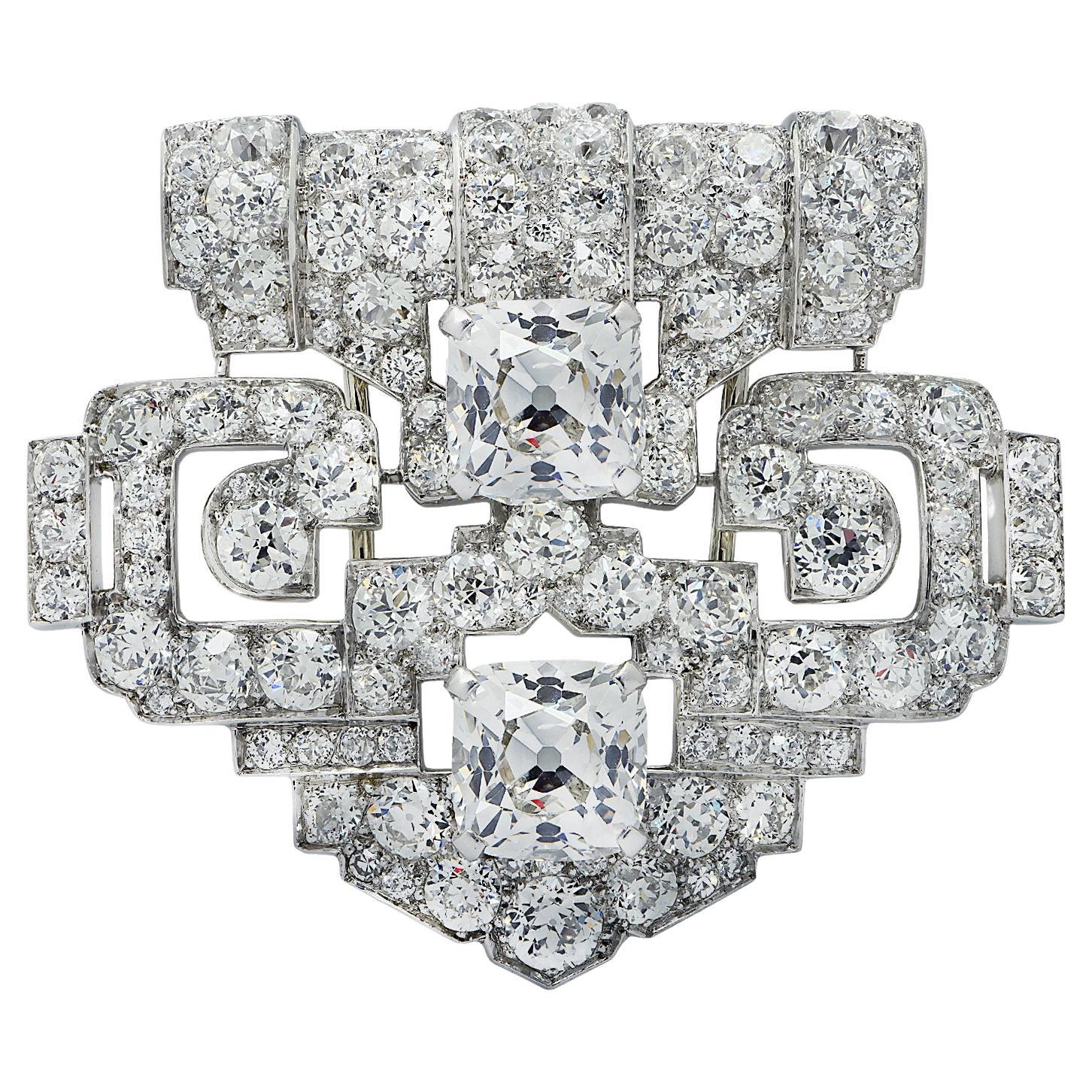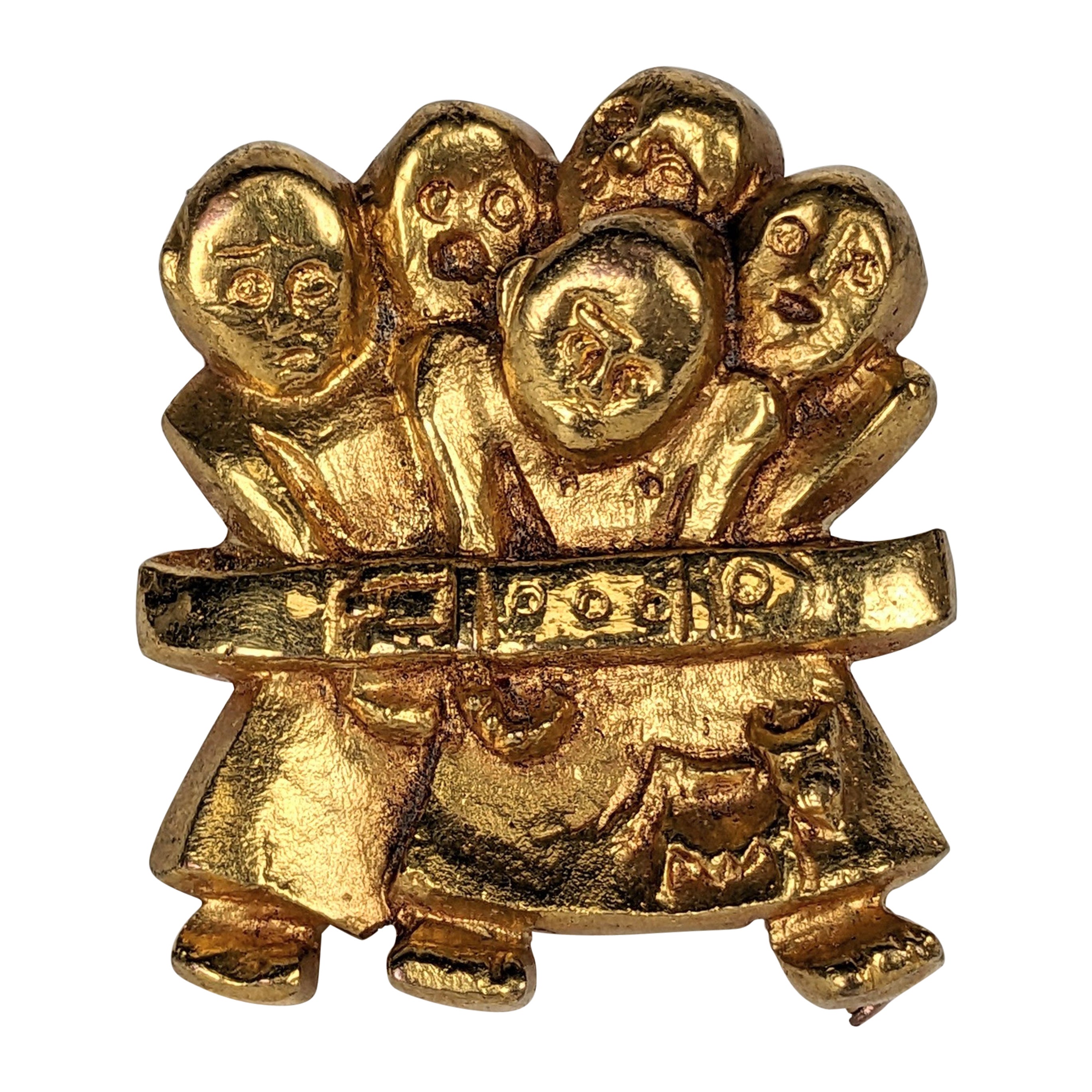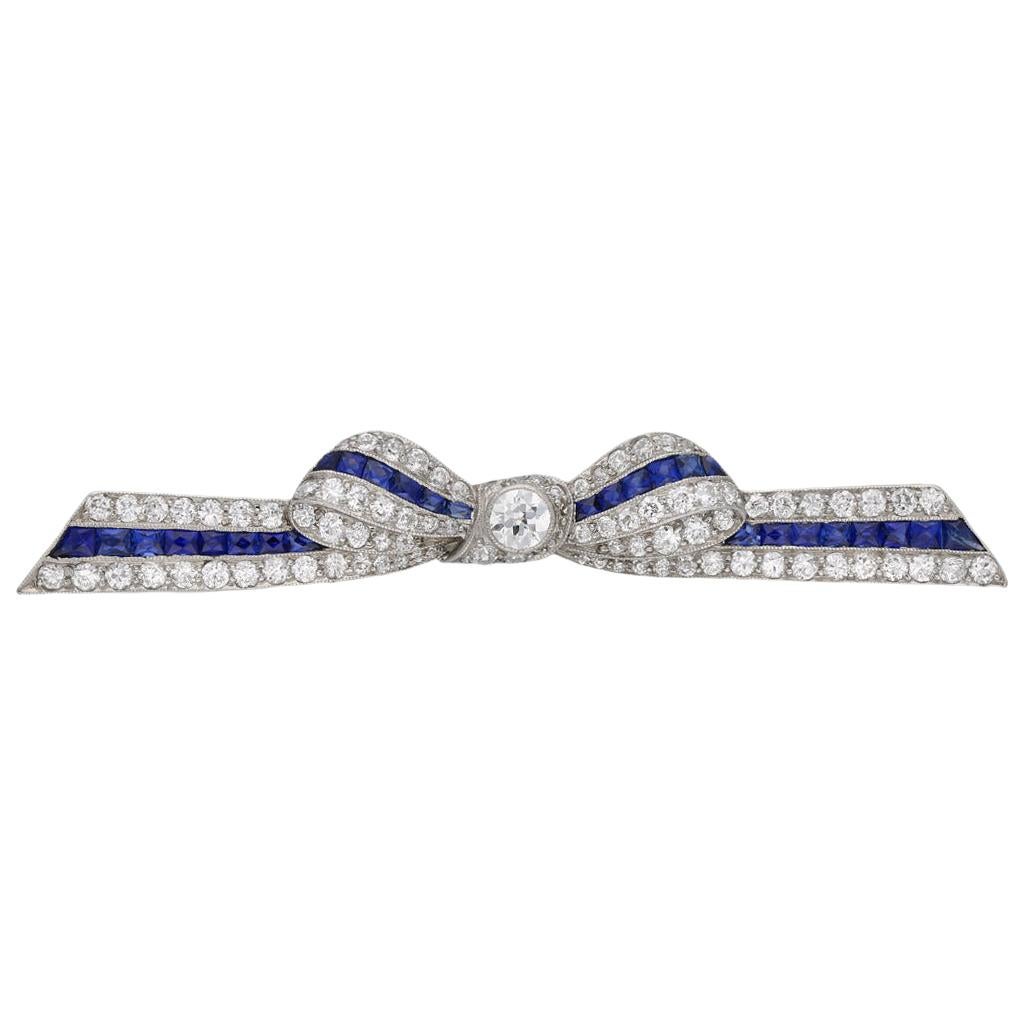CHRISTIAN LACROIX Vintage Gold Tone Resin Heart Brooch
About the Item
- Creator:
- Weight:28 g
- Dimensions:Height: 2.45 in (62 mm)Width: 2.52 in (64 mm)
- Place of Origin:France
- Period:20th Century
- Date of Manufacture:1990s
- Condition:Wear consistent with age and use. Probably hardly or never worn. A pin head hole oxidation spot (see the last picture).
- Seller Location:Nice, FR
- Reference Number:
Christian Lacroix
At a time when sharp padded shoulders and crisp lines were trending, Christian Lacroix created venturesome clothing that was bubbly, flirtatious and exuberant.
The iconic French fashion designer, whose body of work includes handbags and purses, evening dresses, jackets and lots more, has always favored theater over fashion. He has long integrated corsets and bustles into his work, drawing on diverse cultures and citing epic historical dramas as inspirations. Today he is creating opera costumes, so it shouldn’t come as a surprise that his colorful and voluminous garments captured the excesses and defined the extravagant frivolity of the 1980s as well as the sensuality and boldness of the 1990s.
Lacroix studied art history at the University of Montpellier and museum studies at École du Louvre and the Sorbonne in Paris. He aspired to become a museum curator or costume designer but instead entered the world of fashion, specifically haute couture, with the support of his now-wife Françoise Rosenthiel, who helped get his sketches to Hermès. Lacroix was offered an assistant job at the legendary luxury brand and later worked as a designer at the House of Patou in 1981.
Lacroix’s career flourished and his profile soared from then on, as he established his own label in 1987, using layers of fabric and consistently clashing prints in his designs for opulent pouf skirts, vibrant floral maxi day dresses as well as jewelry and watches that commanded attention. He created a ready-to-wear line for Italian manufacturer Genny and dressed dancers at the American Ballet Theatre company.
Lacroix became the artistic director of Italian fashion house Emilio Pucci in 2002, and, over time, he continued to secure work in the fields of theater, opera and other performance art, designing costumes for a range of stage productions. Alongside designs by Stella McCartney, Karl Lagerfeld and others, Madonna wore a corset during her 2004 “Re-Invention World Tour” that was created for her by Lacroix.
Today, the maison founded by the designer in 1987 is owned by the Falic Fashion Group, but Lacroix continues to design womenswear for brands such as Desigual as well as for the stage. His larger-than-life aesthetic has also been translated into a range of accessories and fragrances as well as various interior furnishings such as tableware and household linens. Lacroix has completed interior design projects at a number of hotels and has partnered with the likes of Christofle and other firms over the years. In whatever form it takes, the sumptuousness and glamour of a Lacroix design is unmistakable.
Find a range of vintage Christian Lacroix clothing, jewelry and accessories on 1stDibs.

- ShippingRetrieving quote...Ships From: Nice, France
- Return PolicyA return for this item may be initiated within 2 days of delivery.
- GUY LAROCHE Vintage Jewelled Gold Tone BroochBy Guy LarocheLocated in Nice, FRGUY LAROCHE vintage gold tone brooch embellished with clear crystals. Embossed GUY LAROCHE Paris. Indicative measurements : max. height approx. 5.8 cm (2.28 inches) / max width app...Category
20th Century French Brooches
MaterialsGilt Metal
- CHANTAL THOMASS Vintage Gold Tone Black Enamel Fleur-de-Lis BroochBy Chantal ThomassLocated in Nice, FRCHANTAL THOMASS vintage antiqued gold tone brooch featuring four fleur-de-lis embellished with black enamel and a black tassel. Embossed CHANTAL THOMASS. Indicative measurements : ...Category
20th Century French Brooches
MaterialsGilt Metal
- CHRISTIAN LACROIX Vintage Enamel Cross Brooch PendantBy Christian LacroixLocated in Nice, FRCHRISTIAN LACROIX vintage gold tone brooch/pendant embellished with multicolored enamel and crystals. Marked CHRISTIAN LACROIX CL Made in France. Indicative measurements : height a...Category
20th Century French Brooches
MaterialsGilt Metal
- Chanel Jumbo Logo BroochBy ChanelLocated in Nice, FRCHANEL jumbo logo brooch featuring a rope design in gold tone. Looks gorgeous on a casual denim jacket ! Marked CHANEL 10 P Made in France. Indicative m...Category
21st Century and Contemporary French Brooches
- GIANNI VERSACE Vintage Massive Spiral Modernist BroochBy Gianni VersaceLocated in Nice, FRGIANNI VERSACE by UGO CORREANI vintage massive silver tone spiral modernist brooch embellished with a clear crystal. Embossed GIANNI VERSACE Made in Italy. Indicative measurements ...Category
20th Century Italian Brooches
- KENZO Vintage Silver Tone Floral BroochBy KenzoLocated in Nice, FRKENZO vintage silver tone floral brooch featuring a resin flower and blue glass cabochons. Embossed KENZO Paris Made in France. Indicative measurements : max. height approx. 7 cm (...Category
20th Century French Brooches
- Cartier New York GIA Certified 11.24 Carat Old Mine Cushion Diamond BroochBy CartierLocated in Miami, FLMagnificent Cartier Art Deco Platinum and Diamond Brooch featuring a matching pair of important Old Mine Cut Diamonds weighing 5.60 carats and 5.64 carats. Both accompanied by a GIA report stating that they are H color VS1 and H color VS2 clarity. This brooch comes with an Expertise letter from IAJA (international Antique Jewelers...Category
Vintage 1930s American Art Deco Brooches
MaterialsDiamond, Platinum
- Carved Coral Buddha Pendant in 18k Gold Set with Diamonds, Emeralds and RubiesLocated in Honolulu, HIMAGNIFICENT large vintage Buddha pendant brooch in 18K yellow gold. This gorgeous pendant features a stunning Buddha carved in natural coral set...Category
Late 20th Century Unknown Pendant Necklaces
MaterialsCoral, Diamond, Emerald, Ruby, 18k Gold
- Line Vautrin "La Manif" Gilt Bronze BroochBy Line VautrinLocated in New York, NYGilt brooch by Line Vautrin (1913-1997), circa 1945-46. The design is known as ...Category
Vintage 1950s French Artisan Brooches
MaterialsBronze, Gilt Metal, Gold Plate, Brass
- Vintage Ruby Onyx and Diamond Classic Car BroochLocated in London, GBHere we have a superb vintage brooch. The piece has been crafted from 18ct yellow gold into the shape of a classic car from the 1930s. Automobiles of the 1930s exhibited many notable...Category
Vintage 1930s Brooches
MaterialsDiamond, Onyx, Ruby, Gold, Yellow Gold, Enamel
- Marcus & Co. Sapphire and Diamond Bow Brooch, American, circa 1935Located in London, GBSapphire and diamond bow brooch by Marcus & Co, American, circa 1935. A yellow gold and platinum bow form brooch set with one central row of twenty eig...Category
Vintage 1930s American Art Deco Brooches
MaterialsDiamond, Sapphire, Platinum
- John Brogden Shell Cameo Brooch and Earrings, English, circa 1870By John BrogdenLocated in London, GBAntique shell cameo brooch and earrings by John Brogden, English, circa 1870. A yellow gold suite of jewellery, the brooch composed of a horizontally situated oval Bull’s Mouth shell cameo of the Greek goddess Selene riding a serpentine dragon in a rubover collet setting, encircled by a conforming frame of gold beading and twisted gold wire punctuated with four gold palmette form plaques engraved and decorated with dark blue enamel and placed at the cardinal points, the reverse mounted with a hinged pin and scroll clasp, the earrings each composed of a vertical oval Bull’s Mouth shell cameo engraved with a bust length portrait of Selene with crescent-set headdress, encircled by a conforming frame matching that of the brooch with the addition of a pendant decoration composed of a horizontal bar of gold beading and twisted gold wires suspending gold link chains graduated from centre and ending in conical gold elements, the reverses mounted with French wire fittings, all in a fitted red leather case, the interior marked ‘FIRST CLASS PARIS MEDAL/ 1855.1867.1851/ PARIS FIRST CLASS & LONDON PRIZE MEDALS/ JOHN BROGDON/ Goldsmith/ MANUFACTORY/ 16, Henrietta St. Covent Garden/ London’. The cameo—defined as a gem, usually either a mineral or a shell, upon which a design has been carved in relief—is believed to have originated in Hellenistic Greece, during the third century BC. These miniature sculptures, at that time confined to the medium of hardstone, are thought to have been made with the primary purpose of personal adornment. The same practice of mounting cameos in jewellery was then continued by the Ancient Romans, and they are known to have been worn by many a Roman emperor. After the fall of Rome the fashion for cameos went into a decline, until it was again revived during the Renaissance period, brought about by a keen interest in the ancient world. At this time both antique and contemporary cameos were mounted in jewellery, as well as collected as objet d’art. The art of cameo cutting was revived in Italy, where it would remain a centre for the coming centuries. Again there was a lull in interest in carved gemstones, until the Neoclassical revival of the eighteenth century, largely stimulated by the discoveries of the ancient Roman cities of Pompeii and Herculaneum. As with the Renaissance, antique specimens were generally prized over modern cameos, and the worldliest men in Europe held them among their collections of art and antiques. That said, carving centres in Rome and Torre del Greco (near Naples) in Italy were established in response to the demand of the Grand Tourists, who travelled to Italy and Greece to become educated in the wonders of the ancient world. It was at this time that shell cameos, mostly made in Torre del Greco due to its proximity to the sea, became more popular, owing to the relative ease in carving shell over hardstone. In addition to Rome, hardstone cameos also became a specialty of Idar Oberstein, Germany, which had a long history with both the gem mining and cutting trade. In a shift away from the collector’s cases of the previous century, the nineteenth century saw a strengthening in the fashion for wearable cameos. After the Empress Josephine donned a cameo-set suite of jewellery at the coronation of Napoleon in 1804, cameo jewellery became all the rage. Napoleon played a further hand in promoting the art by establishing a gemstone carving school in Paris, inspired by his appreciation for the arts of the ancient world. By the mid-nineteenth century shell cameos, in part due to their lightness compared with hardstone cameos, were the height of fashion. Large shell cameos as well as hardstone cameos were set into contemporary mounts, often as suites of jewellery. Some of the best cameos of the nineteenth century—carved by a select group of recognized carvers—were set into revivalist mounts, corresponding to the subject matter. In Victorian England cameo jewellery was particularly prized, due in part to the fact that the Queen owned and wore a number of cameo jewels. One example which can often be seen in official portraits is the Badge of the Order of Victoria and Albert, carved by Tommaso Saulini of Rome, who also produced cameos for the maker of the present suite, John Brogden. To meet demand some carvers set themselves up in London, including William Schmidt, a German carver from Idar Oberstein, who produced cameos for top London jewellers, including Brogden, Carlo Giuliano and Child & Child. In fact, Schmidt purports to have been the first to carve cameos out of opal, which Brogden reportedly displayed in the Paris Exhibition of 1878. An extant example, now in the collection of the British Museum, was set by the Giuliano firm. Regarding subject matter, cameos throughout time have been largely figural, from bust length profile portraits to scenes with multiple full-length figures, and sometimes animals. Ancient Greek and Roman cameos often depicted mythological scenes as well as contemporary figures. During the Renaissance, mythological scenes were popular, often taken directly from ancient sculpture, as well as portraits of notable contemporary figures. During the eighteenth and nineteenth centuries, due to the revivalist styles, both Renaissance and Classical subjects were copied and set into matching (and sometimes unmatching) revivalist mounts. From the Renaissance through the Victorian era, being able to recognize the source of the carving in a cameo was a mark of erudition, revealing in the wearer knowledge of Classical art. As mentioned, the present cameo parure...Category
Antique 1870s English Victorian Brooches
MaterialsYellow Gold





